Buddhist Mountain Monasteries in Korea
Magoksa Temple
Magoksa Temple
Introduction
Natural Environment
History
Temple Layout
Cultural Properties
Information
About Magoksa Temple
-
-
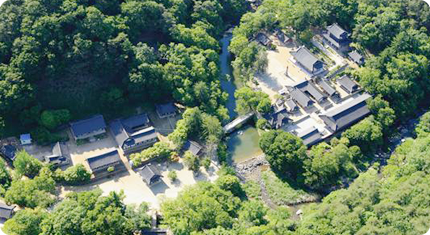 Magoksa Temple
Magoksa Temple
-
Magoksa Temple, situated on Taehwasan Mountain in Gongju-si, Chungcheongnam-do Province, is the main temple of the 6th diocese of the Jogye Order of Korean Buddhism.
The temple site has long been called the “most blessed land of the East” and considered a propitious site. From the perspective of geomancy, the site was classified as a Taegeuk type, and it is considered one of the “ten places of victory” that can avoid war, according to Taengniji and Jeonggamnok. It is also called a “chun-magok-chu-gapsa,” meaning a temple of spring and autumn, to note its breathtaking scenery, especially in those two seasons. With the Taehwacheon Stream flowing in front of the temple, Magoksa was referred to as the “Temple of Water” by Joseon writer Yi Sun-in in a poem depicting its landscape.
-
- In regard to the origin of its name, “Magoksa,” the temple began to attract countless people after Preceptor Bocheol attained the Dharma, and the name, Magoksa (Ma: hemp), was given as a figurative speech to compare the dense crowds to “dense hemp cloth,” as explained by the records, Taehwasan-Magoksa-sajeok-iban.
It is speculated that “Preceptor Magok Bocheol” referred to here was a monk in China, but since there are no records that he ever came to Korea, it is also widely believed that Great Monk Muyeon, who received the Dharma of Monk Bocheol in the late Silla period, was the one who founded this temple and named it Magoksa to honor his master.
In the Naepo region of Chungcheong-do Province, there were temples that were called the “Three Goksa”: Janggoksa Temple of Cheongyang, Magoksa of Gongju and Angoksa of Yesan, which no longer exists.
There is another theory explaining the association between Magoksa and Monk Bocheol. To explain, it is believed that when Gingoljeol and Samgoljeol, the temple names in indigenous Korean, were translated into its Sino-Korean counterparts (i.e. Janggoksa and Magoksa), the name, “Magok,” reminded people of Magok Bocheol from China, and they began associating the founder of Magoksa with Magok Bocheol.
-
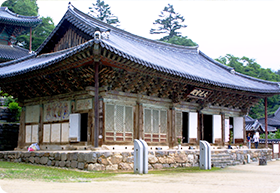 Daegwangbojeon of Magoksa Temple
Daegwangbojeon of Magoksa Temple
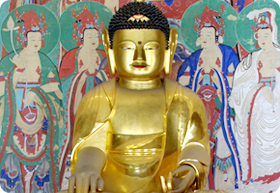 Three Buddhas of Magoksa
Three Buddhas of Magoksa
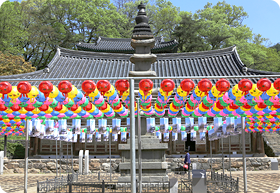 Five-Story Stone Pagoda of Magoksa
Five-Story Stone Pagoda of Magoksa
-
- Magoksa Temple produced countless painter monks that it came to be called Nambanghwaso, or the Southern Painting Center.
There is a painting of Avalokitesvara Bodhisattva (Suwolbaegui-Gwaneumbosal) on the back of the wall behind the main Buddha statue inside the Daegwangbojeon Hall of Magoksa.
This is one of the exemplary paintings demonstrating the history of Magoksa as a temple, carrying the legacy of painter monks including Geumho, Boeung and Ilseop. Also, Seokjeong of Seonggwangsa Temple, considered a master of Buddhist paintings, is said to have studied Buddhist painting under the tutelage of Ilseop of Magoksa Temple.
Magoksa Temple is also associated with Baekbeom Kim Gu, who was an independence activist during the late Joseon period. Kim Gu was imprisoned at Incheon Prison for the murder of a Japanese military officer, who took part in the assassination of Empress Myeongseong. After escaping from prison, he found refuge at Magoksa Temple. -
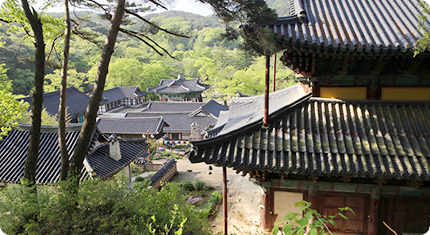 Magoksa Temple
Magoksa Temple
- Magoksa Temple produced countless painter monks that it came to be called Nambanghwaso, or the Southern Painting Center.
There is a painting of Avalokitesvara Bodhisattva (Suwolbaegui-Gwaneumbosal) on the back of the wall behind the main Buddha statue inside the Daegwangbojeon Hall of Magoksa.
This is one of the exemplary paintings demonstrating the history of Magoksa as a temple, carrying the legacy of painter monks including Geumho, Boeung and Ilseop. Also, Seokjeong of Seonggwangsa Temple, considered a master of Buddhist paintings, is said to have studied Buddhist painting under the tutelage of Ilseop of Magoksa Temple.
-
Then, he joined the monastic order under master Haeundang, and gained the Dharma name Wonjong.
Kim Gu stayed at the Baekbeomdang Hall of Magoksa, which now houses a photograph of the independence activist, and in front of Daegwangbojeon, there is a juniper tree that Kim Gu planted after Korea was liberated from the Japanese colonial rule, while reminiscing about the days he spent at the temple.
There are eight hermitages of Magoksa Temple in the mountains: Simjeongam, Buyongam, Bukgaseobam, Toguram, Baengnyeonam, Yeongeunam, Daewonam and Eunjeogam.
